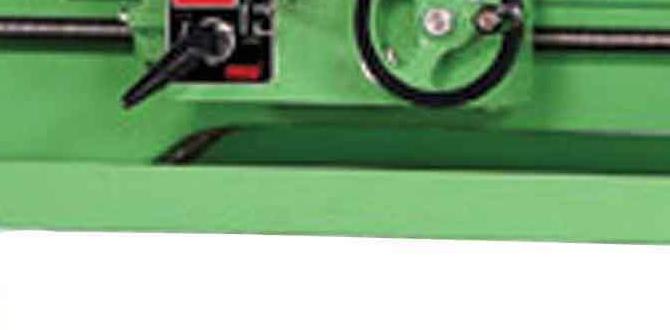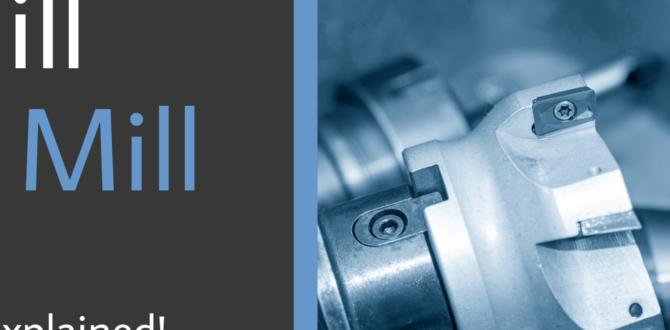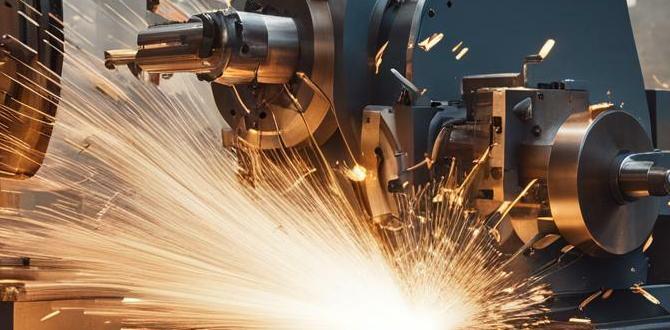CNC lathe machines for precision are advanced tools that automate turning operations to achieve highly accurate and repeatable parts. For beginners, understanding their core functions, benefits, and basic operation is key to unlocking their potential for detailed, professional-quality work in your workshop.
Ever looked at a perfectly smooth, intricately shaped metal part and wondered how it was made with such incredible exactness? Chances are, a CNC lathe was involved. Many beginners find the world of precision machining a bit daunting, especially when advanced tools like CNC lathes come into play. You might think they’re only for big factories. But the truth is, with the right guidance, these machines can bring a new level of accuracy and professionalism to your home workshop projects. Let’s demystify CNC lathes and show you how they can help you create astonishingly precise components, step by step.
What is a CNC Lathe Machine?
At its heart, a CNC lathe is a sophisticated piece of automated machinery used for shaping metal and other materials. “CNC” stands for Computer Numerical Control. This means a computer program directs the entire operation, telling the machine exactly where to move, how fast to spin, and when to cut. A traditional lathe involves a skilled operator manually turning a handle to guide a cutting tool against a spinning workpiece. A CNC lathe automates this process, allowing for incredible precision, speed, and repeatability.
Think of it like this: a manual lathe is like drawing by hand, where your skill and steadiness dictate the outcome. A CNC lathe is like using a digital drawing tablet with specialized software; once the design is programmed, the machine can reproduce it perfectly, over and over again. This automation is what makes them indispensable for achieving the tight tolerances and complex geometries required in many modern engineering and manufacturing applications.
Why Choose CNC Lathes for Precision Work?
The allure of CNC lathes for precision lies in their inherent advantages over manual methods. When accuracy is paramount, these machines truly shine. Here’s why they are the go-to choice for precision:
- Unmatched Repeatability: Once a program is set, a CNC lathe can produce identical parts with virtually no variation, from the first piece to the thousandth. This is crucial for mass production and for creating components that need to fit together perfectly.
- Exceptional Accuracy: Modern CNC lathes are designed with high-precision components and sophisticated control systems that allow them to achieve tolerances measured in microns (thousandths of a millimeter). This level of accuracy is often impossible to achieve reliably with manual machines, especially for complex shapes.
- Complex Geometries: CNC machines can execute intricate cuts, curves, and profiles that would be extremely difficult or time-consuming to produce manually. This opens up possibilities for designing more advanced and functional parts.
- Reduced Human Error: By automating the machining process, CNC lathes minimize the risk of errors caused by operator fatigue, inexperience, or inconsistency.
- Increased Efficiency: While setup can require programming, once running, CNC lathes can operate faster and for longer periods than manual lathes, significantly boosting productivity.
- Material Versatility: They can work with a wide range of materials, from soft plastics and aluminum to hard steels and exotic alloys, consistently achieving precise results.
For hobbyists and small workshops, this means you can tackle projects that demand exact dimensions, create custom parts for intricate mechanisms, or even start a small-scale production run of high-quality items.
Key Components of a CNC Lathe
To understand how a CNC lathe achieves precision, it’s helpful to know its main parts. While designs vary, most CNC lathes share these core components:
| Component | Description | Role in Precision |
|---|---|---|
| Spindle | The part that holds and rotates the workpiece. It’s designed for high speed and stability. | A rigid and balanced spindle ensures the workpiece spins smoothly without vibration, which is critical for accurate cuts. |
| Turret/Tool Post | Holds the cutting tools. It can automatically index (rotate) to bring the correct tool into position for different operations. | Precise positioning of tools is maintained by the turret’s indexing mechanism, ensuring accurate cuts are made at the right points. |
| Axis Drives (X and Z) | Motors (oftenservo or stepper motors) that move the cutting tool along the X (diameter) and Z (length) axes. | These drives use feedback systems (like encoders) to move the cutting tool to incredibly exact positions as dictated by the CNC program. |
| CNC Controller | The “brain” of the machine. It reads the programmed instructions (G-code) and sends signals to the axis drives and spindle. | Interprets complex codes to direct tool paths with micrometre accuracy, coordinating multiple movements simultaneously. Learn more about Computer Numerical Control (CNC) from the National Institute of Standards and Technology (NIST). |
| Workholding Device (Chuck) | Secures the workpiece to the spindle. Common types include 3-jaw chucks, 4-jaw chucks, and collets. | A strong and precisely centered grip by the chuck ensures the workpiece doesn’t slip or wobble during machining, vital for concentricity and accuracy. |
| Bed and Carriage | The main structure providing stability and guiding the movement of the cutting tool. | A robust and highly accurate bed and carriage system prevents flex and ensures the tool moves on a predictable path. |
How CNC Lathes Achieve Precision: The Process
The precision of a CNC lathe isn’t magic; it’s a result of a well-defined process involving design, programming, and the machine’s advanced mechanics. Here’s a simplified breakdown for beginners:
1. Design and the CAD Model
Everything starts with a design. A part is typically designed using Computer-Aided Design (CAD) software. This creates a digital blueprint that specifies every dimension, curve, and feature of the desired component with extreme accuracy.
2. CAM Programming: Translating Design to Machine Instructions
The CAD model isn’t directly understood by the CNC lathe. It needs to be translated into a language the machine can read, using Computer-Aided Manufacturing (CAM) software. The CAM programmer:
- Selects the appropriate cutting tools.
- Defines the cutting strategies (e.g., roughing cuts, finishing passes).
- Determines the toolpaths the cutting tool will follow.
- Specifies cutting speeds, feed rates (how fast the tool moves into the material), and depth of cut.
The CAM software then generates a numerical control (NC) file, most commonly in a format called G-code. G-code is a series of instructions that tells the CNC machine precisely what to do.
3. G-Code and Machine Control
G-code looks like a string of letters and numbers, but each command has a specific meaning:
- G00 Rapid linear move (fast, non-cutting movement)
- G01 Linear interpolation (straight line cutting)
- G02/G03 Circular interpolation (arc cutting, clockwise/counter-clockwise)
- M03/M04 Spindle on/off clockwise/counter-clockwise
- M05 Spindle stop
- X and Z coordinates
- F feed rate
- S spindle speed
The CNC controller reads this G-code and translates it into electrical signals that precisely control the movement of the axis drives and the spindle motor. For example, an instruction like G01 X25.5 Z-10.0 F0.1 tells the machine to move the cutting tool in a straight line to the position X=25.5mm and Z=-10.0mm at a feed rate of 0.1mm per revolution.
4. Machining: The Automated Ballet
Once the G-code is loaded into the CNC controller and the workpiece is securely in the chuck, the machining process begins. The machine:
- Starts the spindle at the programmed speed.
- Positions the first cutting tool.
- Follows the G-code instructions meticulously, moving the tool along the specified paths, cutting away material to form the part.
- Indexes to the next tool as required by the program for different operations.
- Makes multiple passes (roughing and finishing) to achieve the final shape and surface finish.
Throughout this process, the feedback from encoders on the axis drives ensures that the machine knows its exact position at all times, allowing it to make tiny adjustments to maintain accuracy.
Types of CNC Lathes for Precision
Not all CNC lathes are the same. Some are specialized for specific types of precision work:
- Horizontal Lathes: The most common type. The spindle is horizontal, and gravity aids in chip evacuation. They are versatile for a wide range of precision parts.
- Vertical Lathes: The spindle is vertical, meaning the workpiece is held from above. These are excellent for very large, heavy parts as gravity helps to hold them securely. They also offer good chip evacuation.
- Swiss-Type Lathes (Sliding Head Lathes): These are highly specialized for producing very small, slender, and complex parts with extreme precision. The key difference is that the guide bushing supports the workpiece very close to the cutting tool. This significantly reduces vibration and deflection, leading to very high accuracy on long, thin parts.
- Multi-Axis Lathes: These lathes can have more than the basic two axes (X and Z), often including a Y-axis for off-center operations and potentially a sub-spindle for machining both ends of a part in a single setup. This allows for very complex geometries to be machined in one go, further enhancing precision by eliminating alignment errors between setups.
Choosing and Setting Up a CNC Lathe for Precision
For a beginner, selecting and setting up a CNC lathe for precision can seem like a big step. Here’s a practical approach:
Selecting the Right Machine
Consider these factors:
- Project Requirements: What size, material, and complexity of parts do you want to make?
- Accuracy Needs: What level of tolerance is acceptable for your projects?
- Budget: CNC lathes range from affordable hobbyist models to industrial powerhouses.
- Footprint: How much space do you have in your workshop?
- Learning Curve: Some machines and controllers are more beginner-friendly than others.
Many hobbyists start with smaller, benchtop CNC lathes that offer great value and can still achieve impressive precision for many projects. For serious work, a robust industrial-grade machine will offer greater rigidity and advanced features.
Essential Setup Steps for Precision
- Leveling and Mounting: The machine must be perfectly level. Use shims and a precision level. An unstable machine will introduce vibrations and destroy precision. Mount it securely to a heavy, stable base.
- Electrical Connections: Ensure proper grounding and power supply as per the manufacturer’s instructions.
- Tooling and Workholding: Invest in quality cutting tools (inserts and holders) and workholding (chucks, collets). For precision, a good quality 3-jaw chuck or a set of collets is essential.
- Calibration: Many CNC machines come with calibration routines. Ensure you run these to verify axis accuracy and tool offsets. Refer to the tool steel selection guide for understanding material properties that affect machining.
- Initial Testing: Run simple G-code programs to test axis movement, spindle control, and tool changes.
Achieving Precision: Best Practices for Beginners
Once your CNC lathe is set up, here are some practices to focus on for consistent, high-precision results:
Accurate Workholding
The way you hold your workpiece is fundamental. A part that isn’t held perfectly true will not be machined accurately. Ensure your chuck jaws are clean, properly seated, and tightened consistently. For ultimate precision on smaller components, collet chucks are often preferred.
Tooling and Tool Offsets
- Quality Tools: Use sharp, high-quality cutting tools (inserts and holders). Dull tools chatter, produce poor surface finishes, and reduce accuracy.
- Tool Length and Radius Compensation: When you mount a tool, you need to tell the CNC controller its exact length and the radius of its tip. This is done through tool offsets (often stored in a “Tool Offset Table”). Incorrect offsets are a primary cause of dimensional errors.
- Wear Compensation: As tools wear, their effective cutting radius changes. Many CNC controllers allow for backlash and cutter radius compensation (G41/G42) to automatically adjust the toolpath to account for this, ensuring consistent part dimensions throughout the tool’s life.
Material Properties and Machining Parameters
“Machinability” of a material plays a huge role. Different metals and plastics require different cutting speeds, feed rates, and types of tooling. For example, a soft aluminum will machine very differently from a hardened steel. Start with recommended parameters from your tooling supplier or CAM software, and be prepared to make slight adjustments based on how the material is behaving.
Rigidity and Vibration Control
Vibration is the enemy of precision machining. Ensure:
- The machine is rigidly mounted.
- The workpiece is securely gripped.
- Cutting tools are held firmly.
- Corbett cuts are not too aggressive, especially in softer materials.
Listen to the machine. A smooth, consistent cutting sound is good. Any chattering or ringing can indicate a rigidity or parameter issue.
Program Verification and First Part Inspection
- Dry Runs (Air Cuts): Before cutting metal, run the program with the spindle off and the tool clear of the workpiece to visually check the tool’s path and ensure no crashes will occur.
- Single-Block Operation: Run the program one block (line of code) at a time initially. This allows you to stop the machine instantly if something looks wrong.
- First Part Measurement: Always meticulously measure your first part produced after a new setup or program. Use calipers, micrometres, and gauge blocks to verify all critical dimensions against your design specifications.
Safety First!
Operating any machine tool carries risks, and CNC lathes are no exception. As you operate these powerful machines for precision work, always prioritize safety:
- Read the Manual: Thoroughly understand your specific machine’s operation and safety features.
- Wear Safety Glasses: Always, without exception. Consider a full face shield for added protection.
- No Loose Clothing or Jewelry: These can get caught in rotating machinery. Tie back long hair.
- Keep Hands Clear: Never reach into the machine while it’s running or when the spindle is capable of starting.
- Secure Workpieces: A flying workpiece is extremely dangerous. Ensure it’s held firmly.
- Emergency Stop: Know where the E-stop button is and how to use it.
- Chip Management: Use appropriate tools (like chip hooks or brushes) to remove chips, not your hands.
Safe operation is non-negotiable. It protects you, your equipment, and ensures you can continue to enjoy your precision machining projects.
Example Precision Project: A Custom Threaded Rod End
Let’s imagine you need a custom rod end with a specific thread and length that isn’t commercially available. A CNC lathe is perfect for this:
- Design: You’d design a cylindrical rod with a precisely sized shoulder and the required thread profile (e.g., M10x1.5).
- CAM: In CAM software, you’d select a threading tool, define the thread pitch and diameter, and then program a series of passes to cut the thread. You’d also program facing and turning operations for the shoulder and plain sections.
- Machining: The CNC lathe would then accurately turn the rod, face off the end, and precisely cut the external thread to your exact specifications.
- Inspection: You would then use a thread gauge or a micrometer to verify the major diameter of the thread and that it matches your M10 standard, ensuring it will mate correctly with a nut.
This kind of custom part creation is where CNC lathes truly provide immense value for hobbyists and small-scale manufacturers.
Frequently Asked Questions (FAQ)
-
What is the difference between a manual lathe and a CNC lathe?




